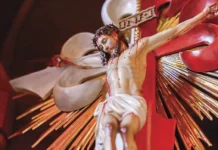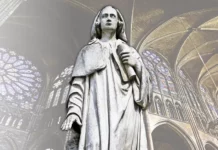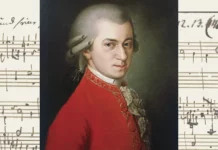The foundations of the Kingdom of Israel, the beginning of the earthly dynasty of Our Lord Jesus Christ, were consolidated by the generous oblation of an heir and the admiring unpretentiousness of a king.
The birth of a new institution sheds light on its future, for the germinative force of every work holds an indication as to its development or stagnation in the future. Everything depends on the first impetus. Moreover, when two providential men are linked together in this unfolding, the union between them will decisively determine the course that will be followed.
So it was with the Chosen People when royalty was born in Israel. It was fitting for the Messiah to be king also according to a human ancestry and, for this reason, the beginning of the Israelite monarchy should contain all the prophetic splendour of its posterity, which would culminate in the Holy Family of the Saviour.
Saul, the king that men desired
It is not known whether some conspiracy to interfere with the divine plan and hour was involved when, through the elders of the people, the prophet Samuel was deposed from his office of judge and a king was demanded in his place, thus beginning the Israelite monarchy (cf. 1 Sm 8:4-6).
Whatever the case, Saul, chosen as the first stone of the institution which, at the fullness of time, would be the temporal palace of the Messiah, was disobedient to the prophet and unfaithful to his call. For this reason, the Lord rejected him (cf. 1 Sm 15) and ordered Samuel to anoint in his place a new chosen one (cf. 1 Sm 16:12-13), a man after God’s own heart (cf. 1 Sm 13:14).
How would the history of the Messianic dynasty have played out had Saul not prevaricated? Was he really called to initiate it? Or could his reign have been merely one of transition, serving only to prepare favourable conditions for the emergence of the Saviour’s dynasty? This is also unknown.
Forsaken by the Spirit of the Lord (cf. 1 Sm 16:14), the deposed king was tormented by another spirit, this time an oppressive one. Nevertheless, God, who had wounded him, did not delay in giving him the remedy. Providential reasons led David, the newly anointed, to serve the royal household. And only the shepherd boy’s playing on the lyre could alleviate the troubled monarch (cf. 1 Sm 16:21-23).

In this way, Providence left Saul an open door to be reconciled with Him: union with David, the king willed by God.
Submission should shine next to royalty
Nothing would prevent the second and definitive beginning of the Israelite monarchy. Nevertheless, the newly anointed still needed to be accepted and recognized as sovereign over the chosen people. It is here that the figure of Jonathan entered on the scene, Saul’s first-born and natural heir to the throne . He immediately perceived the plan hovering over David and humbled himself so as to elevate David and direct him towards the reign which, before his anointing, would have been Jonathan’s own inheritance.
To fully understand this mission, it is necessary to consider that, on the glorious Cross of the Redeemer, His earthly kingship would be recognized and immortalized in this inscription: “Iesus Nazarenus Rex Iudæorum” (Jn 19:19). Reduced to a criminal, inferior even to a slave, it was then that the Messiah’s majesty would be perpetually confirmed, and the sacred standard of the Cross would definitively unite royalty with the most profound submission.
Thus, at the outset of the monarchic lineage of Our Lord Jesus Christ, it was fitting that the regal attribute of the “Ruler of kings on earth” (Rv 1:5) should be prefigured together with the profound humility of Him who, “though He was in the form of God, did not count equality with God a thing to be grasped, but emptied Himself, taking the form of a servant” (Phil 2:6-7).
For this reason, while the Israelites rejoiced in the figure of a monarch who governed them, Providence planned the appearance of a faithful servant, for without him the messianic dynasty could not truly be founded. And it fell to Jonathan to be this vassal. In this way, the chain of loyal and chivalrous submission, symbol of the spirit of union among men according to the new precept of love (cf. Jn 13:34-35), would shine next to David’s crown.
A chivalrous pact marks the birth of the Redeemer’s dynasty

David’s victory over Goliath left everyone, from Saul to the last soldier of Israel, with a mixture of astonishment and bewilderment (cf. 1 Sm 17:38-58). All, yes, except the noble Jonathan. He was more enraptured than surprised. And the attitude he took at the end of the combat against the giant shows a remarkable assurance: “When he had finished speaking to Saul, the soul of Jonathan was knit to the soul of David, and Jonathan loved him as his own soul. […] Then Jonathan made a covenant with David, because he loved him as his own soul. And Jonathan stripped himself of the robe that was upon him, and gave it to David, and his armour, and even his sword and his bow and his girdle” (1 Sm 18:1, 3-4).
It was a beautiful ceremonial transfer of a predilection, pervaded with admiration and recognition! The newly anointed is honoured and clothed by the former heir, who gives proof of his sacrificial and abnegated love by the giving of his person, symbolized by those objects. Indeed, among the Middle Eastern people, the personality also extended to the garments, and the offering of them to another person meant the giving of oneself. 1
Later, the two would renew and consolidate the covenant, including their descendants (cf. 1 Sam 20:14-17; 23:18). These words of the noble Jonathan brought out the supernatural content of the promise: “And as for the matter of which you and I have spoken, behold, the Lord is between you and me for ever” (1 Sm 20:23).
God received from Jonathan’s attitude a heroic act of unpretentiousness, self-denial and generosity. Thus, the monarchical tree of the Chosen People germinated from a relationship similar to the angelic one, and put down roots in the soil of authentic friendship, whose hallmarks are reciprocity of love and mutual benevolence.2
Noble Jonathan, herald of charity
It should be noted that at that moment it was impossible to imagine the future awaiting either of them. In David, the regal grandeur of the greatest monarch of Israel was hidden in the appearance of a simple peasant. Jonathan, in turn, was surrounded by the honours, pomp and riches proper to the king’s first-born son, the heir to a legacy of which he would never take possession. So we may ask: why did the successor to the throne enter into a covenant with a poor shepherd? And why did he love him “as he loved his own soul” (1 Sm 20:17)?
Surely, it was in David’s battle against the Philistine giant that Jonathan glimpsed the prophetic call of the newly anointed one and of his descendants. In fact, the grandeur of the son of Jesse’s vocation was due more to what it announced, namely, the Messiah and his Holy Family, than to the magnificence that his reign would entail.
In the prime of his youth, promising all the glories reserved for the king’s first-born, Jonathan feels that his position is misplaced. Shielding his soul from greed and ambition, he promptly recognizes in that young shepherd his true lord, and in the simple peasant his future monarch. In this way, the reign of David and his descendants receive its first acceptance and homage from Jonathan.

Ultimately, in David, Jonathan loved the Saviour; and, in Jonathan’s charity, David experienced the love of Jesus. In the covenant established with the son of Jesse and his offspring, Saul’s heir entered into an alliance with the Holy Family, and in the uninterrupted oblation of himself for the sake of the newly anointed, for whom he risked his life (cf. 1 Sm 20:24-34), he loved him as Our Lord Jesus Christ would teach us to love our neighbour.
Accordingly, about a thousand years before the Christian era, the noble Jonathan practised the evangelical precept to perfection, becoming himself a prefigure of the Messiah. What David was for royalty, Jonathan was for charity.
Rock of scandal revealing what was hidden in many hearts
After these considerations, it is fitting to ask with St. Ambrose: who would not love David, seeing him so loved by his friends?3 And yet someone hated him!
The envy that once perverted the fratricidal Cain (cf. Gn 4:8) was reborn in Saul, who spared no effort to kill David. His hatred for the son of Jesse made manifest all the execrable vices that he harboured within himself and, from the moment he began his open persecution (cf. 1 Sm 18:10), he degenerated from the monarch deposed by Samuel (cf. 1 Sm 15:10-29) into a usurper of the throne of Israel.
Fool! By fighting against the newly anointed, he was waging war against God. As a result, it was only a matter of time before his irreversible and complete ruin.
Despite Saul’s fierce hostility, the son of Jesse maintained an unaltered respect and veneration for his predecessor, in consideration of the symbolism of royalty previously bestowed upon him by Samuel’s anointing. Saul had not so tarnished his dignity as anointed as to hinder David’s candid admiration.
Jonathan, for his part, wanted to cooperate with grace and serve the providential plan: “Fear not,” he assured David, “for the hand of Saul my father shall not find you; you shall be king over Israel, and I shall be next to you; Saul my father also knows this” (1 Sm 23:17). The care and veneration of Jonathan for the newly anointed, whom from the outset he served with the utmost loyalty and abnegation, were the real foundations of David’s kingdom and his solid throne during the persecutions unleashed by Saul.

David was, then, a true rock of scandal that revealed what was hidden in many hearts. Some hated him, others loved him; no one remained indifferent before him.
The culmination of the alliance with David and his posterity
A sacral penumbra veils the last, perhaps supreme, episode in Jonathan’s life. The Holy Scriptures are sparing in their account of his death (cf. 1 Sm 31:1-2). How did the earthly existence of this man close, he whose conduct was a prophetic clarion call of Christian charity?
Immolation is the greatest proof of love: “Greater love has no man than this, that a man lay down his life for his friends” (Jn 15:13). And Jonathan could not have omitted this supreme self-giving.
Talis vita, finis ita. In accordance with his noble life, it is licit to believe that, on the heights of the mountains of Gilboa, he culminated the alliance established with David and his descendants by shedding his blood, for “where a will is involved, the death of the one who made it must be established. For a will takes effect only at death, since it is not in force as long as the one who made it is alive” (Heb 9:16-17).
The golden sequence of acts of generosity he had practised demanded that his days should be closed with this golden seal: the termination of his life in holocaust for his royal peer. In this way, Jonathan’s oblation was present in the consolidation of the Messianic royalty, and his union of soul with David became eternal.
David bitterly mourned the death of his noble friend, dedicating to him and to Saul one of the most beautiful tributes of the Old Testament.4 In this hymn, the king-prophet curses the mountain on which the shield of heroes had been dishonoured (cf. 2 Sm 1:21), but – may he forgive us – it would have been more appropriate to exclaim: “Blessed mountains of Gilboa, Jonathan was slain upon thy heights!” In fact, the plateau where the sacrifice of Jonathan was consummated became the evocative figure of another hill, on which the Divine Victim would expire, whose Death would initiate the New and Eternal Testament.
Finally, the earthly dynasty of the Redeemer had sprung up, grounded in the relationship of mutual charity between David and Jonathan, the fruit of a covenant so momentous that some have seen in it a prefigurement of the pact of love and peace signed between Christ and the Church. 5 ◊
In the featured photo: David and Jonathan – Cathedral of St. Giles, Edinburgh; Mount Gilboa (Holy Land) in background
Notes
1 Cf. ARNALDICH, OFM, Luis. Biblia comentada. Libros históricos del Antiguo Testamento. Madrid: BAC, 1961, v.II, p.251.
2 Cf. ST. THOMAS AQUINAS. Summa Theologiae. II-II, q.23, a.1.
3 Cf. ST. AMBROSE. Los deberes de los ministros, 2, 7, 36. In: FRANKE, John R. (Ed.). La Biblia comentada por los Padres de la Iglesia. Antiguo Testamento. Madrid: Ciudad Nueva, 2009, v.IV, p.386.
4 Cf. ARNALDICH, op. cit., p.288.
5 ST. BEDE. Comentarios a los Libros de Samuel, 3, 18. In: FRANKE, op. cit., p.369.







